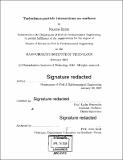Turbulence-particle interactions on surfaces
Author(s)
Inizan, Maxime
DownloadFull printable version (16.59Mb)
Other Contributors
Massachusetts Institute of Technology. Department of Civil and Environmental Engineering.
Advisor
Lydia Bourouiba.
Terms of use
Metadata
Show full item recordAbstract
The physics of adhesion and detachment of particles in ventilation ducts is important to understand and control contaminant and pathogen dispersal indoors. This thesis presents an experimental characterization of parameters which affect the resuspension of settled micro-particles and spores in a turbulent airflow channel. We examine, quantify, and analyze the role of relative humidity (RH), air temperature, particle size, and surface properties on particle detachment rate and mode. This is done using a combination of high-speed imaging in a turbulent channel where spores and particles are deposited initially followed by image-processing and particle-tracking. First, we show that ambient moisture hinders particle detachment, however, we also find that this is only true for a relative humidity higher than 60% RH. At lower air saturation, we show that, instead, another effect dominates, leading to a different mode of detachment. Instead of individual particle detachment, it is a collision dynamics leading to cluster formation that dominates the pattern of detachment of particles from surfaces. We find that collisions lead to aggregations of particles on the surface in the form of clusters of self-similar sizes. We find that the larger the cluster (above 5 particles) the more anisotropic its shape, similarly to what was observed in prior literature examining clusters of air-suspended particles in channel flows. We examined and quantified the role of initial particle surface concentration, mean air velocity, and particle surface properties on these results. Our study have implications in the control of pathogen and contaminant dispersal in confined geometries, relevant for a wide range of applications.
Description
Thesis: S.M., Massachusetts Institute of Technology, Department of Civil and Environmental Engineering, 2018. Cataloged from PDF version of thesis. Includes bibliographical references (pages 105-110).
Date issued
2018Department
Massachusetts Institute of Technology. Department of Civil and Environmental EngineeringPublisher
Massachusetts Institute of Technology
Keywords
Civil and Environmental Engineering.